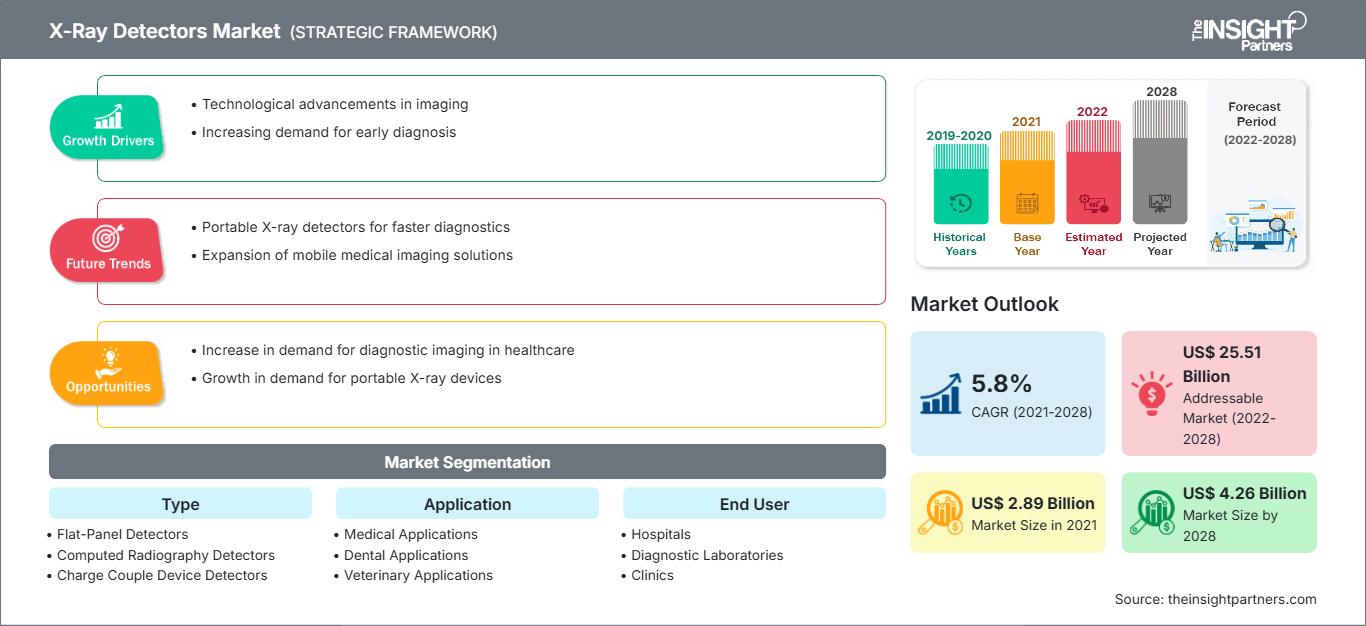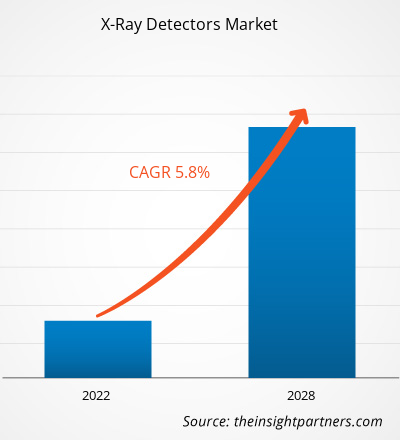[Informe de investigación] Se prevé que el tamaño del mercado de detectores de rayos X alcance aproximadamente los 4.256,75 millones de dólares estadounidenses para 2028; se espera que crezca a una tasa de crecimiento anual compuesta (TCAC) del 5,8% entre 2022 y 2028.
Los detectores de rayos X son dispositivos que se utilizan para medir el flujo, la distribución espacial, el espectro y otras propiedades de los rayos X. En el ámbito sanitario, se emplean habitualmente en aplicaciones médicas con diversos fines diagnósticos. El diseño de los detectores de rayos X varía en tamaño, forma, resolución espacial, frecuencia de imagen y flujo de rayos X, entre otras características, para cumplir con los requisitos de cada aplicación.
El mercado de detectores de rayos X se segmenta según el tipo, la aplicación, el usuario final y la geografía. Geográficamente, se divide en Norteamérica, Europa, Asia Pacífico, Oriente Medio y África, y Sudamérica y Centroamérica. Este informe ofrece información y un análisis exhaustivo del mercado, haciendo hincapié en parámetros como las tendencias y la dinámica del mercado, así como en el análisis competitivo de los principales actores a nivel mundial.
Obtendrá personalización gratuita de cualquier informe, incluyendo partes de este informe, análisis a nivel de país y paquetes de datos de Excel. Además, podrá aprovechar excelentes ofertas y descuentos para empresas emergentes y universidades.
Mercado de detectores de rayos X: Perspectivas estratégicas

- Obtenga las principales tendencias clave del mercado que se describen en este informe.Esta muestra GRATUITA incluirá análisis de datos, que abarcarán desde tendencias de mercado hasta estimaciones y pronósticos.
Perspectivas del mercado
Entre los principales factores que impulsan el crecimiento del mercado se incluyen la creciente incidencia y prevalencia de trastornos crónicos, así como los lanzamientos y aprobaciones de productos.
Las enfermedades crónicas, como las cardiovasculares, respiratorias y ortopédicas, así como diversos tipos de cáncer, provocan discapacidades y mortalidad en todo el mundo. Estas afecciones clínicas impactan la calidad de vida. Según la Organización Mundial de la Salud (OMS), se estima que más del 50 % de la población mundial padece al menos una enfermedad crónica. Los Centros para el Control y la Prevención de Enfermedades (CDC) indicaron que 6 de cada 10 personas en Estados Unidos padecían al menos una enfermedad crónica en 2019. Las enfermedades cardiovasculares (ECV), derivadas de un estilo de vida agitado, son una causa importante de mortalidad a nivel mundial. Los trastornos ortopédicos se encuentran entre las principales causas de años de vida ajustados por discapacidad (AVAD) observados en la gran población geriátrica a nivel mundial. Según un artículo publicado por SingleCare, más de 350 millones de personas en todo el mundo vivían con artritis en 2021. Países como Estados Unidos, Japón, Corea del Sur, Canadá, Reino Unido, España y Francia están experimentando un crecimiento sustancial de su población geriátrica. Estas economías, junto con China, India, Arabia Saudita, los Emiratos Árabes Unidos y Brasil, ofrecen importantes oportunidades de crecimiento para introducir dispositivos innovadores en el mercado mundial de detectores de rayos X.
A continuación se enumeran algunos ejemplos de avances que han impulsado el crecimiento del mercado de detectores de rayos X:
- En octubre de 2022, Rigaku Corporation, fabricante líder de equipos de análisis e inspección de rayos X, lanzó su nuevo detector XSPA-400 ER (X-ray Seamless Pixel Array) al mercado global tras un exitoso lanzamiento nacional en JASIS (Japan Analytical and Scientific Instruments Show) en septiembre de 2022. El XSPA-400 ER es un detector multidimensional de píxeles sin costuras para difractómetros de rayos X con alta resolución energética, adecuado para el análisis de baterías, acero y cerámica.
- En agosto de 2021, Rigaku Corporation adquirió la totalidad de las acciones emitidas de MILabs BV el 2 de agosto de 2021, como parte de su estrategia integral para ingresar al sector de las ciencias de la vida. Mediante esta adquisición, Rigaku expandirá su negocio de modalidades para ciencias de la vida a nivel mundial, combinando las unidades de negocio multimodal de MILabs, que incluyen tomografía por emisión de positrones (PET), tomografía computarizada por emisión de fotón único (SPECT), imagen óptica y equipos de tomografía computarizada (TC) para animales, con el negocio original de imagenología de rayos X para animales de Rigaku.
- En septiembre de 2021, Canon adquirió Redlen. Esta adquisición permitirá a Canon obtener tecnología avanzada de detección de radiación e imagen utilizada en los módulos detectores semiconductores CZT, que desempeñan un papel fundamental en el desarrollo de la tomografía computarizada por conteo de fotones (PCCT). Esto permitirá a Canon Medical Systems Corporation, también filial de Canon, acelerar el desarrollo de sistemas PCCT competitivos para fortalecer su negocio de sistemas médicos.
Información sobre el producto
Según su tipo, el mercado de detectores de rayos X se segmenta en detectores de radiografía computarizada (CR), detectores de panel plano, detectores de escaneo lineal y detectores CCD (dispositivos de carga acoplada). El segmento de detectores de panel plano representó la mayor cuota de mercado en 2021 y se prevé que registre la mayor tasa de crecimiento anual compuesto (CAGR) durante el período de pronóstico. Los sistemas de rayos X suelen utilizar detectores de panel plano indirectos para la conversión de la energía de los rayos X en energía lumínica, la cual se emplea para generar imágenes de inspección radiográfica. Los detectores de panel plano también se utilizan en radiografía digital para convertir los rayos X en carga (conversión directa), que posteriormente se interpreta mediante una matriz de transistores de película delgada.
Perspectivas regionales del mercado de detectores de rayos X
Los analistas de The Insight Partners han explicado en detalle las tendencias regionales y los factores que influyen en el mercado de detectores de rayos X durante el período de previsión. Esta sección también analiza los segmentos y la geografía del mercado de detectores de rayos X en Norteamérica, Europa, Asia Pacífico, Oriente Medio y África, y Sudamérica y Centroamérica.
Alcance del informe de mercado de detectores de rayos X
| Atributo del informe | Detalles |
|---|---|
| Tamaño del mercado en 2021 | US$ 2.890 millones |
| Tamaño del mercado para 2028 | 4.260 millones de dólares estadounidenses |
| Tasa de crecimiento anual compuesto global (2021 - 2028) | 5,8% |
| Datos históricos | 2019-2020 |
| período de previsión | 2022-2028 |
| Segmentos cubiertos | Por tipo
|
| Regiones y países cubiertos | América del norte
|
| Líderes del mercado y perfiles de empresas clave |
|
Densidad de los participantes en el mercado de detectores de rayos X: comprensión de su impacto en la dinámica empresarial
El mercado de detectores de rayos X está creciendo rápidamente, impulsado por la creciente demanda de los usuarios finales debido a factores como la evolución de las preferencias de los consumidores, los avances tecnológicos y una mayor conciencia de los beneficios del producto. A medida que aumenta la demanda, las empresas amplían su oferta, innovan para satisfacer las necesidades de los consumidores y aprovechan las nuevas tendencias, lo que impulsa aún más el crecimiento del mercado.

- Obtenga una visión general de los principales actores del mercado de detectores de rayos X.
Detectores de rayos X – Segmentación del mercado
El mercado de detectores de rayos X se segmenta según el tipo, la aplicación, el usuario final y la geografía. Por tipo, se divide en detectores de radiografía computarizada (CR), detectores de panel plano, detectores de escaneo lineal y detectores CCD (dispositivos de carga acoplada). Por aplicación, se divide en aplicaciones médicas, dentales, veterinarias y otras. En cuanto al usuario final, se segmenta en hospitales, laboratorios de diagnóstico, clínicas y otros usuarios finales. Geográficamente, se divide en Norteamérica (EE. UU., Canadá y México), Europa (Reino Unido, Alemania, Francia, Italia, España y el resto de Europa), Asia Pacífico (China, Japón, India, Australia, Corea del Sur y el resto de Asia Pacífico), Oriente Medio y África (Emiratos Árabes Unidos, Arabia Saudita, África y el resto de Oriente Medio y África) y Sudamérica y Centroamérica (Brasil, Argentina y el resto de Sudamérica y Centroamérica).
Perfiles de empresas
- PerkinElmer Inc
- Varian Medical Systems Inc
- FUJIFILM Holdings Corp
- Teledyne Technologies Inc
- Analogic Corp
- Konica Minolta Inc
- Canon Inc
- Varex Imaging Corp
- Corporación Rigaku
- Moxtek Inc
- Análisis histórico (2 años), año base, pronóstico (7 años) con CAGR
- Análisis PEST y FODA
- Tamaño del mercado, valor/volumen: global, regional y nacional
- Industria y panorama competitivo
- Conjunto de datos de Excel
Informes recientes
Informes relacionados
Testimonios
Razón para comprar
- Toma de decisiones informada
- Comprensión de la dinámica del mercado
- Análisis competitivo
- Información sobre clientes
- Pronósticos del mercado
- Mitigación de riesgos
- Planificación estratégica
- Justificación de la inversión
- Identificación de mercados emergentes
- Mejora de las estrategias de marketing
- Impulso de la eficiencia operativa
- Alineación con las tendencias regulatorias






















 Obtenga una muestra gratuita para - Mercado de detectores de rayos X
Obtenga una muestra gratuita para - Mercado de detectores de rayos X